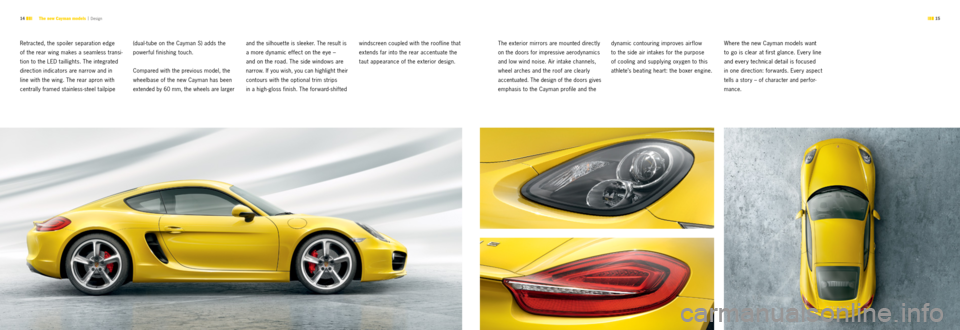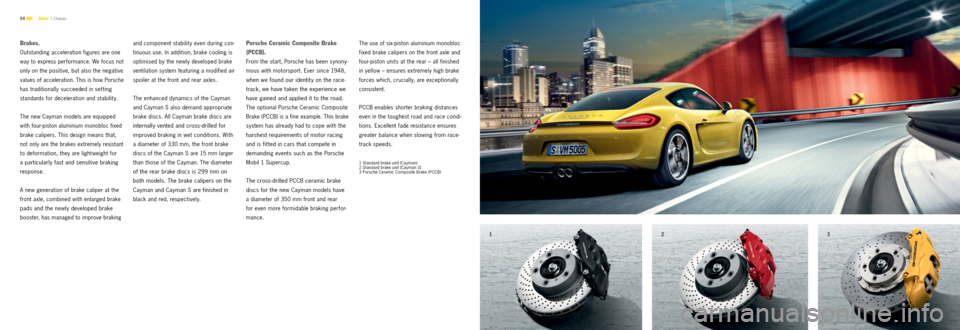cooling PORSCHE CAYMAN S 2012 2.G Information Manual
[x] Cancel search | Manufacturer: PORSCHE, Model Year: 2012, Model line: CAYMAN S, Model: PORSCHE CAYMAN S 2012 2.GPages: 69, PDF Size: 19.31 MB
Page 8 of 69

15
14 The new Cayman models |
Design
(dual-tube on the Cayman S) adds the
powerful finishing touch.
Compared with the previous model, the
wheelbase of the new Cayman has been
extended by 60 mm, the wheels are larger
Retracted, the spoiler separation edge
of the rear wing makes a seamless transi -
tion to the LED taillights. The integrated
direction indicators are narrow and in
line with the wing. The rear apron with
centrally framed stainless-steel tailpipe and the silhouet te is sleeker. The result is
a more dynamic effect on the eye –
and on the road. The side windows are
narrow. If you wish, you can highlight their
contours with the optional trim strips
in a high-gloss finish. The forward-shifted windscreen coupled with the roofline that
extends far into the rear accentuate the
taut appearance of the exterior design.
The exterior mirrors are mounted directly
on the doors for impressive aerodynamics
and low wind noise. Air intake channels,
wheel arches and the roof are clearly
accentuated. The design of the doors gives
emphasis to the Cayman profile and the dynamic contouring improves airflow
to the side air intakes for the purpose
of cooling and supplying oxygen to this
athlete’s beating heart: the boxer engine.
Where the new Cayman models want
to go is clear at first glance. Every line
and every technical detail is focused
in one direction: forwards. Every aspect
tells a story – of character and perfor -
mance.
Page 17 of 69

32
resonance intake manifold.
The resonance effect, where the air mass
inside the intake manifold is caused to
oscillate, is used to improve air induction
and, in turn, to optimise the formation
of the fuel/air mixture. In the Cayman S,
the manifold is also equipped with a
switchable resonance valve.
The results are high torque, a uniform
torque curve and high power output.
The sound produced is characteristically
resonant and deep.
Direct fuel injection (DFI).
Direct fuel injection (DFI) is featured as
standard in both Cayman models. Multi-
hole injectors deliver fuel directly into the
combustion chamber with millisecond
precision. The injection pattern has been
optimised for torque, power output, fuel
consumption and emissions. Combustion
is even more effective as a result.
With direct injection, the engine manage -
ment system regulates injection timing
individually for each cylinder as well as
the injection rate for each cylinder bank.
This optimises the combustion process
and therefore fuel economy. Depending on the engine operating con
-
dition, multiple fuel injections take place
so that the cataly tic converter reaches
normal operating temperature sooner
after a cold start and a greater top-end
torque can be achieved.
DFI improves the internal cooling of the
combustion chamber by having the mix -
ture prepared directly in the cylinder. This
allows for a higher compression ratio,
which helps to deliver greater power out -
put at the same time as enhanced engine
efficiency. Injection is regulated by the
electronic engine management system
and emissions are monitored by the
stereo Lambda sensors, thus helping to
protect the environment.
For fuel consumption, CO
2 emissions and efficiency class, please refer to page 131.
Drive |
Engine
Page 19 of 69

12
36
Thermal management.
The intelligent thermal management
system in the Cayman models regulates
the temperature in the engine and gear -
box
to reduce friction losses that occur
during the warm-up phase.
Thanks to the purposeful control of heat
flow and on-demand, gradual activation
of the various cooling circuits, the engine
and gearbox warm up to normal operat -
ing temperature more rapidly. The result -
ing reduction in friction also reduces fuel
consumption and CO
2 emissions. During
sporty driving, thermal management also
acts to reduce temperatures so as to
maintain a high degree of performance. Our cross-flow cooling system, as used
in motorsport, supplies each engine cylin -
der uniformly with coolant, which protects
all valves against thermal overload and,
therefore, premature wear. This improves
combustion and keeps emissions, fuel con -
sumption and noise comparatively low.
exhaust system.
In the new Cayman models, each cylinder
bank has its own stainless-steel exhaust
tract. Downstream of their respective rear
silencer, the tracts converge into a con -
necting tube and a single (Cayman) or t win
(Cayman S) tailpipe. The stereo Lambda
control circuitr y
controls and monitors each cylinder bank
separately. For each
exhaust tract, four
corresponding oxygen sensors regulate
the composition of the exhaust gas and
monitor the performance of the catalytic
converters. The separate
tracts enable
the exhaust gas to flow more
f re e l y. T h e
resulting reduction in pressure loss has
a positive impact on power output, torque
and the unmistakable engine sound.
Available as an option for the new Cayman
models is the sports exhaust system*
including sports tailpipe. It produces an
even more resonant Porsche sound.
1 Standard tailpipe of the Cayman S
2 Standard tailpipe of the Cayman
* Available from 03/2013 at the earliest.
Drive |
Engine
Page 28 of 69

1231 23
54
Brakes.
Outstanding acceleration figures are one
way to express performance. We focus not
only on the positive, but also the negative
values of acceleration. This is how Porsche
has traditionally succeeded in setting
standards for deceleration and stability.
The new Cayman models are equipped
with four-piston aluminium monobloc fixed
brake calipers. This design means that,
not only are the brakes extremely resistant
to deformation, they are light weight for
a particularly fast and sensitive braking
response.
A new generation of brake caliper at the
front axle, combined with enlarged brake
pads and the newly developed brake
booster, has managed to improve braking
and component stability even during con -
tinuous use. In addition, brake cooling is
optimised by the newly developed brake
ventilation system featuring a modified air
spoiler at the front and rear axles.
The enhanced dynamics of the Cayman
and Cayman S also demand appropriate
brake discs. All Cayman brake discs are
internally vented and cross-drilled for
improved braking in wet conditions. With
a diameter of 330 mm, the front brake
discs of the Cayman S are 15 mm larger
than those of the Cayman. The diameter
of the rear brake discs is 299 mm on
both models. The brake calipers on the
Cayman and Cayman S are finished in
black and red, respectively.
Porsche Ceramic Composite Brake
(PCCB).
From the start, Porsche has been synony -
mous with motorsport. Ever since 1948,
when we found our identit y on the race -
track, we have taken the experience we
have gained and applied it to the road.
The optional Porsche Ceramic Composite
Brake (PCCB) is a fine example. This brake
system has already had to cope with the
harshest requirements of motor racing
and is fit ted in cars that compete in
demanding events such as the Porsche
Mobil 1 Supercup.
The cross-drilled PCCB ceramic brake
discs for the new Cayman models have
a diameter of 350 mm front and rear
for even more formidable braking perfor -
mance.
The use of six-piston aluminium monobloc
fixed brake calipers on the front axle and
four-piston units at the rear – all finished
in yellow – ensures extremely high brake
forces which, crucially, are exceptionally
consistent.
PCCB enables shorter braking distances
even in the toughest road and race condi -
tions. Excellent fade resistance ensures
greater balance when slowing from race -
track speeds.
1 Standard brake unit (Cayman)
2 Standard brake unit (Cayman S)
3 Porsche Ceramic Composite Brake (PCCB)
Drive |
Chassis